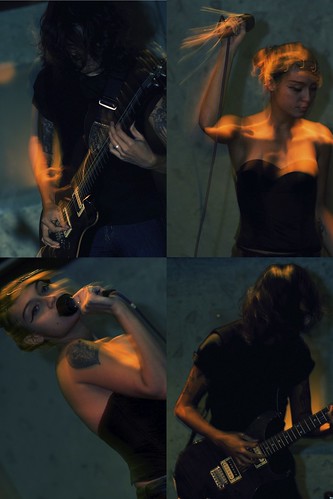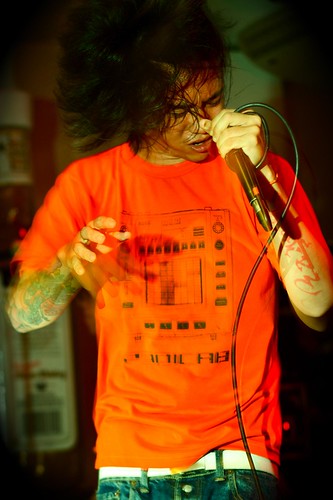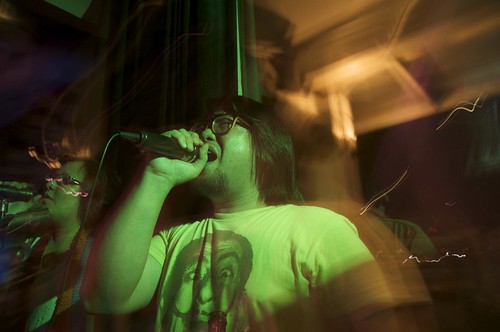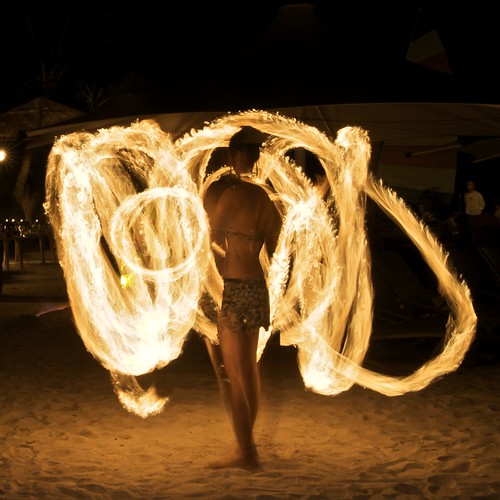Capturing flash motion is a favorite photography subgenre of mine, probably because it’s notoriously easy to pull off once you’ve got your camera settings sorted. On my D90, I shoot with an 85mm lens open at f/2.5, ISO 200. I like the 85mm for this because it’s very light compared to any of my zooms, and this technique involves a lot of camping (i.e., holding the camera to your face for several minutes doing nothing, then blasting off 5 shots in quick succession).
Shutter speed should be in the non-handholdable* range of 1/5 to 1/8, depending on how much of the background I want to be able to resolve in the image. You have to make sure that your strobe syncs rear-curtain; every camera has a slightly different way of doing this. I believe compact cameras have these too, so theoretically you should be able to pull this off even if you’re not using a DSLR.
Right before the gig starts I usually take a few images of the stage area so I can see what kind of flash power I need to illuminate it appropriately. For Route196 last night, this was 1/4 to 1/8 on my smallish SB-600 flash (with an aperture of f/2.2 to f/3.2).
Then it’s just a matter of waiting for the right moment. These flash-motion portraits work best when the subject is about to make a quick move. Guitarists are super-easy because there’s a lot of repetition in their hand movements, so you’ll have a lot of chances to get something nice. Essentially, you open your shutter right as the move’s being executed. If you do it right, you’ll get a nice motion blur around the subject.
*Why non-handholdable? The rule of thumb when judging whether a particular shutter speed is "handholdable" is 1/focal-length. In other words, on my 85mm, I shouldn’t be able to handhold the camera at anything lower than 1/80-1/100. The reason is due to the fact that longer focal lengths magnify vibrations, so you are more likely to end up with blurry images. Conversely, if you had a very wide lens, like Canon’s 10-22mm, you could handhold that even at 1/10 or 1/15 and still get a decently sharp image.
Strobes allow us to cheat this law because the light coming from our flashes travels at around 1/1000 or faster. When you are making a flash-enabled exposure, the area illuminated by the strobe will be crystal-clear because it was lit at a speed much, much higher than your handhold minimum. Meanwhile, everything that wasn’t lit by the strobe (your background, usually) will still exhibit all the usual camera-shake. This is why you want to have your aperture open pretty wide when capturing flash-motion. Since your background will be pretty shaky, you want to bokeh it out as much as possible.
One of my first really decent flash-motion images from back in May 2009. (In photographer-years, I was 3 months old at the time.) Ironically, this is of Miggy Chavez of Chicosci, but let’s not judge. This was pretty textbook stuff: 50mm lens at f/2.5, 1/20 shutter speed. (I didn’t own an 85mm back then. And oh, I was still shooting Canon.)
Although my recent flash-motion images have been taken with on-camera flash, I occasionally have the luxury of setting up colored, off-camera strobes. The image above was taken in Magnet High Street with a green-gelled flash clamped to a ladder about 4 feet away from the subject. I guess I must’ve been feeling cocky that night coz my settings were all over the place: 2 second exposure handheld, f/8 opening and 17mm focal length.
This fire-dancer image pushes the limit of the flash-motion technique. In order to track the flames as they moved around the subject, I had to shoot a 4-second exposure, which is impossible to handhold, no matter what you do. So I tripoded it - the sane solution. The flash hardly did anything in this instance because the light from the fire was already more than enough to expose the dancer in its center. This actually speaks to an important caveat in shooting flash-motion: if the subject is throwing off a lot of its own light, your flash is unnecessary, unless you want to try to overpower the subject’s light with your own.
The rest of my flash-motion portraits can be found here.



